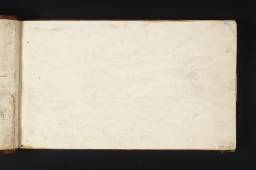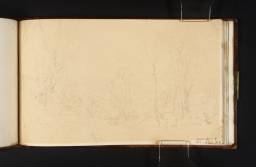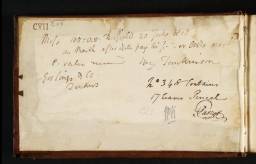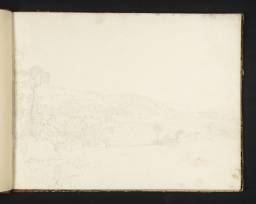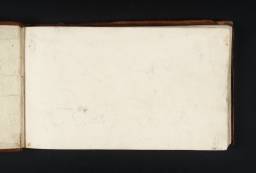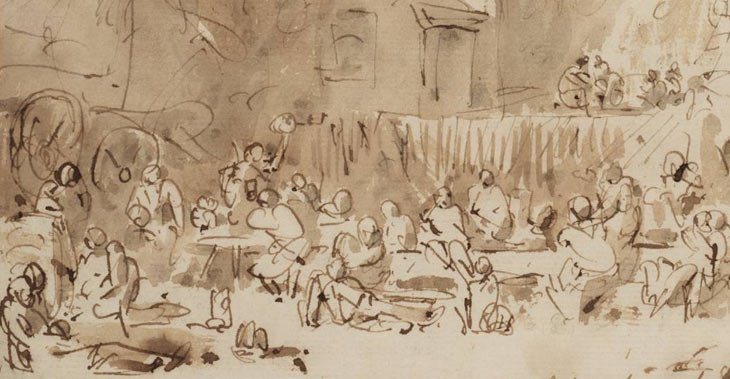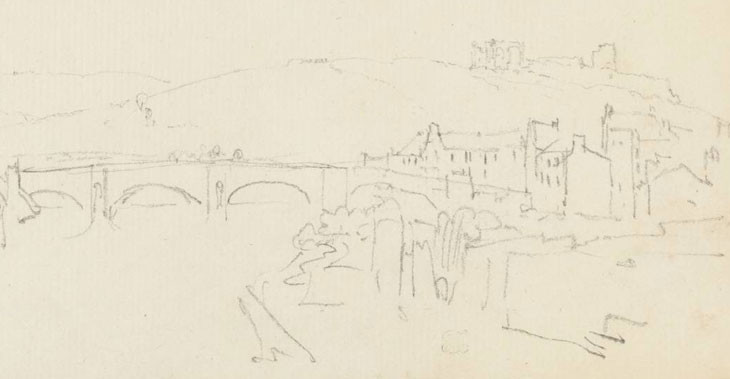Sketchbooks used at Tabley, Cheshire and in Derbyshire, North Wales, Lancashire and Yorkshire 1808
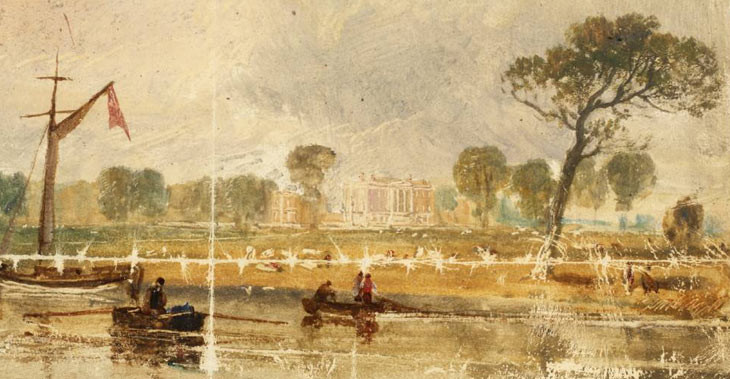
From the entry
In the summer of 1808, Turner toured in the North and North-West. He visited Sir John Leicester to paint his seat, Tabley House, near Knutsford, Cheshire and made an expedition into North Wales, to visit the Dee Valley, Bala and perhaps the coast. Returning to Tabley, he moved on to Lancashire and Yorkshire, visiting the Ribble Valley and the Craven Dales and making the first of many annual visits to Walter Fawkes at Farnley Hall, near Otley, for the shooting. Turner’s route to the North-West seems to have been through the Midlands to Derbyshire and along Dovedale. He was away about three months, from July when he missed three General Assemblies at the Royal Academy, to the end of September. These sketchbooks record many places visited and throw much light on his movements, but do not give a definitive picture as their contents have sometimes been rearranged or dispersed and not all subjects are identified. The order given above should be regarded as provisional. The Kirkstall book contains the earliest date, 20 July ...
Derbyshire sketchbook 1808
D07132–D07198; D07201–D07204; D07208–D07249; D07251–D07254; D17156–D17157; D40624–D40627
Turner Bequest CVI
D07132–D07198; D07201–D07204; D07208–D07249; D07251–D07254; D17156–D17157; D40624–D40627
Turner Bequest CVI
In the summer of 1808, Turner toured in the North and North-West. He visited Sir John Leicester to paint his seat, Tabley House, near Knutsford, Cheshire and made an expedition into North Wales, to visit the Dee Valley, Bala and perhaps the coast. Returning to Tabley, he moved on to Lancashire and Yorkshire, visiting the Ribble Valley and the Craven Dales and making the first of many annual visits to Walter Fawkes at Farnley Hall, near Otley, for the shooting. Turner’s route to the North-West seems to have been through the Midlands to Derbyshire and along Dovedale. He was away about three months, from July when he missed three General Assemblies at the Royal Academy, to the end of September.
These sketchbooks record many places visited and throw much light on his movements, but do not give a definitive picture as their contents have sometimes been rearranged or dispersed and not all subjects are identified. The order given above should be regarded as provisional. The Kirkstall book contains the earliest date, 20 July, along with a note citing Dorfold Hall, Nantwich, Cheshire, and its owner Henry Tomkinson (D07255; Turner Bequest CVII Inside Front Cover). It also notes alternative routes from Manchester to Otley, near Farnley (D07257; Turner Bequest CVII 1), and from Knutsford to Lichfield via Congleton and to Otley (D07256; Turner Bequest CVII Inside Back Cover). However, subjects elsewhere in these sketchbooks suggest that Turner went different ways and Kirkstall is otherwise devoted to views of Kirkstall Abbey, probably drawn on an expedition from Farnley. The Derbyshire book has views of Burton-on-Trent, Staffordshire (D07149; Turner Bequest CVI 14), the Dove aqueduct and the Trent and Mersey Canal near Egginton (D07150; Turner Bequest CVI 15) and closes in Yorkshire with views of Harewood Castle and Bridge (for example D07249, D07246: Turner Bequest CVI 87, 85a). Other drawings possibly from 1808, closely connected with Farnley and Fawkes and with related Yorkshire subjects, are catalogued separately by David Hill.1
Of the three Tabley books, Tabley No.1 and Tabley No.3 contain Turner’s drawings of the house and the lake or Moat in the grounds, and other material presumably connected with his stays there such as scores for the flute. Tabley No.3 notes information about pictures hanging in the house (D07025; Turner Bequest CV 32) and interior décor. Tabley No.1 has drawings (D06845–D06846; Turner Bequest CIII 15a–16) and an oil sketch (D06848; Turner Bequest CIII 18) for Tabley, Cheshire, the Seat of Sir J.F. Leicester, Bart.: Calm Morning (Tate T03878; displayed at Petworth House),2 exhibited at the Royal Academy in 1809. Tabley No.3 contains material (D06990, D07002; Turner Bequest CV 7, 17) for its companion, Tabley, the Seat of Sir J.F. Leicester, Bart.: Windy Day (Tabley House Collection, University of Manchester).3 These pictures were Turner’s first commissioned country house portraits in oil and soon generated more such orders, notably from the Earls of Egremont and Lonsdale.4 As well as the modern mansion at Tabley, Turner explored the Old Hall on its island in the Moat and the family chapel, St Peter’s, that then stood alongside (for example D07116; Turner Bequest CV 84). Turner’s stay at Tabley was a working holiday, when he is said to have spent most of his time fishing but probably did more work than fellow guests appreciated, rising early to catch the first light. Evidently, his visit was punctuated by his excursion to Wales and he seems to have brought work back with him to Tabley.
Already an important collector and patron of Turner and other modern British painters, Sir John Leicester belonged to a group of clients and admirers whose interlocking friendships, hospitality and commissions framed the context for the artist’s tour in 1808. Sir John was a longstanding friend of Sir Richard Colt Hoare of Stourhead, whose summer villa by Llyn Tegid near Bala was probably Turner’s destination during his Welsh trip, after the Dee Valley and on the way to the coast. Hoare usually visited Bala in July, often with Sir John whom he then joined at Tabley for Knutsford races. In 1808, he was at Bala for two weeks until 4 August, and again 16–25 August; he was at Tabley on 7 September and then went to visit Thomas Lister Parker at Browsholme Hall in Lancashire. As this itinerary closely coincided with Turner’s they may have travelled some of the way together. Hoare and Leicester shared Turner’s love of fishing and Leicester’s ownership of fishing rights on the Ribble at Ribchester could have attracted the artist to the river. Turning eastwards along the River Calder, Turner visited Whalley where he drew the bridge and abbey, the resulting picture, Whalley Bridge and Abbey, Lancashire: Dyers Washing and Drying Cloth (private collection),5 being possibly intended for Parker who had advised Dr Thomas Dunham Whitaker on antiquarian matters for his History of Whalley, published in 1800–1 with illustrations after Turner. In 1805, Whitaker had published a History of Craven and Turner’s tour of the Craven Dales in 1808 covered similar ground, possibly with a view to contributing plates to a new edition,6 while views of key sites were subsequently commissioned by Fawkes.
Tabley No.1 was used in Wales, Lancashire and Yorkshire as well as at Tabley, its Welsh material dovetailing with more in Tabley No.2. The first book has views of Valle Crucis Abbey near Llangollen (D06843, D06842; Turner Bequest CIII 14, 13) which Turner later used for his watercolour of the abbey for Picturesque Views in England and Wales (Manchester Art Gallery)7, and one of Bala and Llyn Tegid (D06831; Turner Bequest CIII 2) while views of Llangollen are in Tabley No.2 (see note to D06960; Turner Bequest CIV 77a) together with a number depicting the winding, rock-hugging road between Corwen and Betws-y-Coed near Ty-nant and Pont-y-Glyn (see note to D06871; Turner Bequest CIV 10), a well-known beauty spot. One intriguing sketch shows a small coach-party (?Hoare’s or Sir John Leicester’s) halting near the bridge to admire the view (D06876; Turner Bequest CIV 14). Turner’s fishing interests are evident in the same book which depicts a fly-fisherman (D06860; Turner Bequest CIV 3) and, nearby, lists items including a fishing rod to take on a trip (D06862; Turner Bequest CIV 4a). Also in this book (D06893; Turner Bequest CIV 28a) is the basis of the small painting Trout Fishing in the Dee, Corwen Bridge and Cottage (Taft Museum, Cincinnati, Ohio)8 which is usually thought to have been started at Tabley on Turner’s return from Wales.
However, the same book contains several drawings (especially D06920; Turner Bequest CIV 47a) for the unfinished picture or oil sketch River Scene with Cattle (Tate N01857)9 which is recorded as hanging in the Picture Gallery at Tabley in 1809 in a watercolour dated that year by John Chessell Buckler (Tabley House). This would suggest that the oil was painted at Tabley, from the drawings Turner brought back with him from Wales, and left behind at the end of his visit, to be returned to him at a later date. A possible location for the subject would be the Mawddach Estuary near Barmouth, which Turner could have visited from Bala. From the later stages of the 1808 tour, Tabley No.1 has views of Giggleswick and Ingleborough (D06834; Turner Bequest CIII 5), Chapel-le-Dale (D06830; Turner Bequest CIII 1), ‘Ribblesdale Leap’ (D06855; Turner Bequest CIII 3) and Whalley related to Whalley Bridge and Abbey (D06835; Turner Bequest CIII 6 and especially D06837; Turner Bequest CIII 8), and of Malham Cove, Yorkshire (D06839; Turner Bequest CIII 10) used for a watercolour (British Museum, London)10 perhaps made for Fawkes before circa 1810 with other Yorkshire subjects.
Turner’s preparations for his lectures as Professor of Perspective at the Royal Academy were under way by 1808, and his description at the back of Tabley No.2 (D06983; Turner Bequest CIV 88) of a ‘white Body’ floating past him in the Dee and a longer passage about reflections in water in Tabley No.3 (D40630, D07114) anticipate his observations on ‘Reflexes’ (reflections) in Lecture 5, first given in 1811. In the Derbyshire book are notes on Sir Joshua Reynolds’s Royal Academy Discourses (D07219, D07217; Turner Bequest CVI 71a, 70a) and on English grammar and usage (D07212–D07214; Turner Bequest CVI 67–8), as well as various drafts of poetry, some of it like verses on ‘Silver Thames’, the seasons and addressed to ‘honest John Bull’ approximating to versions in other sketchbooks, notably Greenwich (Tate D06721–D06829; D40666–D40668; Turner Bequest CII) and Yorkshire 5 (Tate D11518–D11595; D40860–D40862; Turner Bequest CXLVIII), and based on recent sources. Inside the back cover of Tabley No.1 (D40721) appears a list of historical subjects, evidently connected with the Liber Studiorum. Turner’s source for most of his notes on grammar, Hugh Blair’s Lectures on Rhetoric and Belles-Lettres (1783 and subsequent editions), was notable for its division of poetry into distinct categories such as Pastoral and Epic and has been suggested as an inspiration for Turner’s thematic classification of landscape in the Liber.11
As regards dating, Tabley No.3 was in use the longest of these books. While some of its material on picture-hanging, curtains and drapery may reflect what Turner saw at Tabley in 1808, other plans for a picture gallery and its top-lighting and heating must be intended for his own London premises. They are closest to the final incarnation of Turner’s Gallery, opened in 1822, behind his Queen Anne Street house. Numerous views of London and the River Thames in the book must be later still, made in connection with a proposed series of prints of London scenes. Views including Robert Smirke’s additions to the Custom House fronting the Pool of London (for example D07083; Turner Bequest CV 66a) date from 1825.
Notable in Derbyshire (D07188; Turner Bequest CVI 48a) is what appears to be Turner’s first plan of the grounds of his new property at Twickenham, bought in 1807, where he was later to build Sandycombe Lodge.
Additional Material:
Possibly from 1808 and associated with Turner’s stay at Farnley that year are various Yorkshire subjects: Barden Tower, Wharfedale (Tate D12110; Turner Bequest CLIV L); Addingham Mill on the Wharfe (Tate D12111; Turner Bequest CLIV M); The Valley of the Wharfe (Tate D12112; Turner Bequest CLIV N); Gordale Scar (Tate D12113; Turner Bequest CLIV O); Newall Old Hall (Tate D12114; Turner Bequest CLIV P); Bolton Abbey (Tate D12115–D12118; Turner Bequest CLIV Q–T); The Strid, Bolton Woods (Tate D12119; Turner Bequest CLIV U); and The Washburn (Tate D12120, D12121; Turner Bequest CLIV V, W). See, in this catalogue, Hill, Farnley and Related Subjects.
Acknowledgements:
The author is grateful to David Hill and Eric Shanes for sharing their thoughts on this material, and also wishes to remember the late Lieutenant-Colonel John Leicester-Warren, who first showed him Tabley.
Martin Butlin and Evelyn Joll, The Paintings of J.M.W. Turner, revised ed., New Haven and London 1984, pp.70–1 no.99 (pl.107).
See Sketchbooks Connected with Work in Sussex, Yorkshire and Cumbria for the Earls of Egremont and Lonsdale, 1809.
How to cite
David Blayney Brown, ‘Sketchbooks used at Tabley, Cheshire and in Derbyshire, North Wales, Lancashire and Yorkshire 1808’, February 2011, in David Blayney Brown (ed.), J.M.W. Turner: Sketchbooks, Drawings and Watercolours, Tate Research Publication, December 2012, https://www

